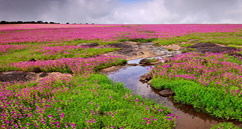Kaas Lake
The Kaas lake is nothing but the " smallest part of the Kaas Pathar" which is situated in the Western Ghat Sahyadri range, 23 kilometers from Satara city in Maharashtra state of India. The name Kaas originates from Kaasa tree (Elaeocarpus glandulosus). Leaves of this tree turn green to red as they mature. It gets white flowers only for 15 days in the month of March. The area of plateau is approximately 1,000 hectare.
The plateau is full of wild flowers during the months of August and September. These flowers bloom on their own and stay for about 2–3 weeks (depending on the monsoon and other weather factors). Recently it has been declared as Biodiversity World Heritage Site by The United Nations Educational Scientific and Cultural Organization (Unesco). It has an small lake nearby, so when you are driving down the curves from Kaas Plateau you see a sign on left saying - Kaas Talav. It is a natural tranquil. Kaas lake is surrounded by dense forests. To the left of the lake lies Sajjangad fort and the Kanher Dam lies to the right. It is a famous picnic spot with the locals. The place has more than 850 different species of flowers and other plants including Orchids, Karvy and carnivorous plants such as Drosera Indica. This falls under the Sahyadri Sub Cluster ofWestern Ghats which is now a UNESCO World Heritage Site. To visit Kaas plateau, register on the website www.kas.ind.in
Geography
Kaas plateau is a plateau located around 23 km from Satara. There are two ways to reach lake. one the more direct way from Satara and another from Tapola via the link road connecting Mahabaleshwar and Panchgani to Kas Pathar. The link road facilitates tourists in staying in Tapola or Mahabaleshwar after visiting Kas Pathar rather than the Satara town or cutting the weekend picnic short and making it a one day weekend picnic. Kas plateau is 20 km away from Northern part of Koyana Sanctuary. The major portion of the plateau is reserve Forest. Kaas lake (built 100 years ago) is a perennial source of Water supply for western part of Satara city by gravity. The flora of Kaas are around the locality of that area. The plateau is largely formed of basalt which is directly exposed to atmosphere. The basalt rock is covered by a thin cover of soil formed due to erosion and has accumulated a layer of not more than an inch or so. This soil is neither black nor lateritic. At certain places water gets accumulated because of uneven surface. The plants growing on Kas plateau are typically of herbaceous nature of like grasses. The small shrubs and trees are located at the periphery of the plateau at Kaas plateau.
The various distances of Kas palteau are as follows:
From Satara - 25 km
From Pune - 125 km
From Mumbai - 280 km
